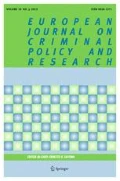Abstract
It is supposed that threats of punishment deter potential criminals from committing crimes. The correctness of this theory is, however, questionable. Numerous empirical investigations have come to different results. In this article a meta-analysis is described which tries to find out the reasons for the different findings. First evaluations indicate that the methods of research have an influence on the results and that a possible deterring effect of the penal law can only be covered reasonably with a very differentiating model. Not all criminal acts can be influenced by deterrence. It appears that the most significant deterrent effects can be achieved in cases of minor crime, administrative offences and infringements of informal social norms. In cases of homicide, on the other hand, the meta-analysis does not indicate that the death penalty has a deterrent effect. According to the results, the validity of the deterrence hypothesis must be looked at in a differenciated manner.















Similar content being viewed by others
Notes
In high sample sizes t-values under -1.96 are significant on the 5% level. This marginal value is lower in the case of small sample sizes. “Normalisation” consists of an adjustment of the t-values with small sample size; for these cases t-values are calculated that would be obtained were the sample size higher, but the probability of error for the estimate remains unchanged. As a result of this normalisation, the value t=-1.96 is always the boundary between significant and non-significant estimates, irrespective of the sample size.
References
Antony, J., & Entorf, H. (2003). Zur Gültigkeit der Abschreckung im Sinne der ökonomischen Theorie der Kriminalität: Grundzüge einer Meta-Studie. In H.-J. Albrecht, & H. Entorf (Eds.), Kriminalität, Ökonomie und Europäischer Sozialstaat (pp. 167–185). Heidelberg: Physica-Verlag.
Atteslander, P. (2003). Methoden der empirischen Sozialforschung. 12th edn. Berlin: Schmidt-Verlag.
Beccaria, C. (1766). Über Verbrechen und Strafen. Übersetzt und herausgegeben von W. Alff, 1988. Frankfurt/Main: Insel-Verlag.
Becker, G. S. (1968). Crime and Punishment: an Economic Approach. Journal of Political Economy, 76(2), 169–217.
Bentham, J. (1823). An Introduction to the Principles of Morals and Legislation. Überarbeitete Auflage, 1907. Oxford: Clarendon Press.
Buikhuisen, W. (1974). General Deterrence: Research and Theory. Abstracts on Criminology and Penology, 14(3), 285–298.
Cameron, S. (1988). The Economics of Crime Deterrence: A Survey of Theory and Evidence. Kyklos, 41(2), 301–323.
Coleman, J. (1991). Grundlagen der Sozialtheorie, Vol. 1: Handlungen und Handlungssysteme. München: Oldenbourg Verlag.
Diekmann, A. (2008). Empirische Sozialforschung. Grundlagen, Methoden, Anwendungen. 19th edition Reinbek: Rowohlt.
Ehrlich, I. (1973). Participation in Illegitimate Activities: A Theoretical and Empirical Investigation. Journal of Political Economy, 81(3), 521–565.
Eisele, H. (1999). Die general- und spezialpräventive Wirkung strafrechtlicher Sanktionen. Methoden, Ergebnisse, Metaanalyse (Ph.D. thesis). Heidelberg, University of Heidelberg.
Esser, H. (1999). Soziologie. Spezielle Grundlagen, Vol. 1: Situationslogik und Handeln. 3rd edn. Frankfurt/M.: Campus.
Farin, E. (1994). Forschungsperspektive und Methodik der Metaanalyse. Forschungsberichte des Psychologischen Instituts der Albert-Ludwigs-Universität, No. 113. Freiburg i. Br.: Albert-Ludwigs-Universität.
Feuerbach, P. J. A. (1799). Revision der Grundsätze und Grundbegriffe des positiven peinlichen Rechts 1. Erfurt: Henningsche Buchhandlung.
Fricke, R., & Treinis, G. (1985). Einführung in die Metaanalyse. Methoden der Psychologie, Vol. 3. Bern u.a.: Huber.
Hedges, L. V., & Olkin, I. (1985). Statistical Methods for Meta-Analysis. San Diego: Academic Press.
Kreuzer, A. (2004). Prävention durch Repression. In J.-M. Jehle (Ed.), Angewandte Kriminologie zwischen Freiheit und Sicherheit (pp. 205–218). Mönchengladbach: Forum Verlag.
Kromrey, H. (2006). Empirische Sozialforschung. 11th edn. Opladen: UTB Leske + Budrich.
Nagin, D. (1978). General Deterrence: A Review of the Empirical Evidence. In A. Blumstein, J. Cohen, & D. Nagin (Eds.), Deterrence and Incapacitation: Estimating the Effects of Criminal Sanctions on Crime Rates (pp. 95–139). Washington D.C.: National Academy Press.
Rosenthal, R. (1991). Meta-Analytic Procedures for Social Research. Revised Edition. Beverly Hills: Sage.
Rupp, T. (2008). Meta Analysis of Crime and Deterrence: A Comprehensive Review of the Literature (Ph.D. thesis). Darmstadt: Technical University. http://tuprints.ulb.tu-darmstadt.de/1054/2/rupp_diss.pdf(11/2008)
Stanley, T. D. (2001). From Wheat to Chaff: Meta-Analysis as Quantitative Literature Review. Journal of Economic Perspectives, 15(3), 131–150.
Wolf, F. M. (1986). Meta-Analysis. Quantitative Methods for Research Synthesis. University Paper Series on Quantitative Applications in the Social Sciences 59. Thousand Oaks, CA: Sage.
Author information
Authors and Affiliations
Corresponding author
Rights and permissions
About this article
Cite this article
Dölling, D., Entorf, H., Hermann, D. et al. Is Deterrence Effective? Results of a Meta-Analysis of Punishment. Eur J Crim Policy Res 15, 201–224 (2009). https://doi.org/10.1007/s10610-008-9097-0
Published:
Issue Date:
DOI: https://doi.org/10.1007/s10610-008-9097-0



